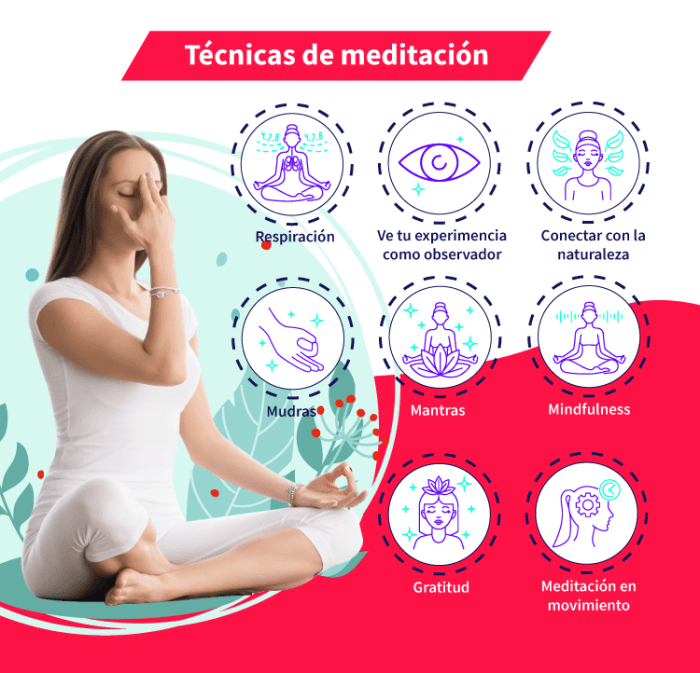6 Strategies to Improve Meditation Concentration sets the stage for this enthralling narrative, offering readers a glimpse into a story that is rich in detail and brimming with originality from the outset.
Understanding the challenges of maintaining focus in meditation and exploring techniques to overcome them is crucial for a successful practice.
Introduction to Meditation Concentration: 6 Strategies To Improve Meditation Concentration

Meditation concentration refers to the ability to focus your mind and attention on a single point or object during meditation practice. This involves training your mind to eliminate distractions and maintain a heightened state of awareness.Improving concentration during meditation is crucial as it allows you to deepen your practice and experience the full benefits of meditation. By enhancing your ability to concentrate, you can achieve a greater sense of calm, clarity, and inner peace.The benefits of enhancing meditation concentration are numerous.
It can help reduce stress and anxiety, improve cognitive function, enhance emotional well-being, and promote overall mental health. Additionally, increased concentration can lead to a greater sense of presence and mindfulness in everyday life.
Understanding the Challenges of Meditation Concentration
When trying to improve meditation concentration, it’s important to recognize the various challenges that can hinder this process. Understanding these obstacles can help practitioners address them effectively.External factors such as noise, temperature, or discomfort in the environment can easily disrupt concentration during meditation. These distractions can make it hard to focus and enter a state of deep meditation.Internal obstacles, such as racing thoughts, emotional turmoil, or physical discomfort, can also impede concentration during meditation.
For example, a busy mind constantly wandering to different thoughts or feelings can make it difficult to stay focused on the present moment.
Common Distractions that Hinder Meditation Concentration
- Electronic devices like phones or laptops buzzing with notifications.
- Noisy neighbors or street sounds disturbing the peaceful atmosphere.
- Physical discomfort such as an uncomfortable sitting position or muscle tension.
Impact of External Factors on Concentration, 6 Strategies to Improve Meditation Concentration
- Temperature fluctuations affecting comfort levels during meditation.
- Unpleasant odors or smells in the environment distracting the mind.
- Visual distractions like cluttered spaces or flickering lights.
Examples of Internal Obstacles to Focus
- Racing thoughts about past or future events disrupting concentration.
- Emotional distress or anxiety causing inner turmoil during meditation.
- Physical sensations like itching or pain diverting attention away from the practice.
Techniques to Enhance Meditation Concentration
Improving concentration during meditation can be achieved through various techniques that help cultivate mindfulness, focus, and relaxation.
Mindfulness Techniques to Improve Focus
- Practice present moment awareness by focusing on sensations in the body, breath, or surroundings.
- Acknowledge distractions without judgment and gently bring your focus back to the present moment.
- Cultivate gratitude and compassion through loving-kindness meditation to enhance positive emotions and focus.
Deep Breathing Exercises for Concentration
- Engage in diaphragmatic breathing to calm the mind and increase oxygen flow to the brain, promoting focus.
- Counting breaths or focusing on the rhythm of inhalation and exhalation can anchor your attention and improve concentration.
- Use breathing techniques such as box breathing or alternate nostril breathing to regulate the breath and enhance mindfulness.
Visualization Methods to Enhance Meditation Concentration
- Imagine a peaceful place or visualize a calming scene to create a mental sanctuary for your meditation practice.
- Visualize a glowing light or energy at the center of your being, radiating peace and focus throughout your body and mind.
- Picture a specific object or symbol in your mind’s eye and concentrate on its details to sharpen your focus and concentration.
Creating a Suitable Environment for Better Concentration

Creating the right environment for meditation is crucial for improving concentration. A peaceful and conducive space can help you focus better and deepen your practice. Here are some tips to enhance your meditation space and minimize distractions.
Choose the Right Meditation Space
When selecting a meditation space, opt for a quiet and clutter-free area where you feel comfortable. This could be a corner of your room, a dedicated meditation room, or even a serene outdoor spot. Make sure the space is clean and organized to promote relaxation and focus.
Minimize Distractions
To minimize distractions, turn off electronic devices, such as phones or TVs, and inform others in your household about your meditation schedule. You can also use earplugs or play soft instrumental music to block out external noises. Creating a boundary around your space, such as using a room divider or curtain, can help maintain privacy and reduce interruptions.
Lighting and Ambiance
Lighting plays a significant role in setting the mood for meditation. Natural light is ideal, but if that’s not possible, opt for soft, diffused lighting with candles or dimmer switches. Choose calming colors for your meditation space, such as blues, greens, or earth tones, to create a tranquil ambiance. Adding cushions, blankets, or incense can further enhance the atmosphere and promote relaxation.
Utilizing Sound and Music for Meditation Concentration

When it comes to enhancing meditation concentration, sound and music can play a significant role in helping individuals focus their mind and enter a deeper state of relaxation. The use of specific sounds or music can create a calming atmosphere, drown out external distractions, and guide the practitioner into a more profound meditative state.
Benefits of Using Binaural Beats or White Noise
One popular method for enhancing meditation concentration is through the use of binaural beats or white noise. Binaural beats are created when two different frequencies are presented separately to each ear, causing the brain to perceive a third tone that is the difference between the two frequencies. This can help synchronize brainwaves and induce a state of relaxation and focus.
Ways to Incorporate Sound Therapy into Meditation Practices
There are several ways to incorporate sound therapy into meditation practices. One simple method is to play calming music or nature sounds in the background while meditating. This can help create a peaceful ambiance and drown out any distracting noises from the environment. Additionally, using singing bowls, gongs, or other musical instruments specifically designed for meditation can enhance the overall experience and aid in concentration.
Practicing Regularly and Maintaining Consistency

Maintaining a consistent meditation practice is crucial for improving concentration over time. By establishing a routine and sticking to it, you can train your mind to focus better during meditation sessions.
Strategies for Staying Committed to Regular Meditation Sessions
- Set a specific time each day for meditation to create a habit.
- Start with realistic goals and gradually increase the duration of your meditation sessions.
- Keep a meditation journal to track your progress and stay motivated.
- Find an accountability partner or join a meditation group to stay motivated and accountable.
- Remind yourself of the benefits of meditation to maintain your commitment.
How Consistency Improves Overall Meditation Concentration
Consistency in meditation practice allows your mind to become more familiar with the process, making it easier to enter a focused state. Over time, regular meditation sessions help strengthen your ability to concentrate, leading to improved focus and mental clarity in daily life.
Closing Summary

In conclusion, mastering the art of meditation concentration through these strategies can lead to a profound sense of inner peace and mindfulness. Implementing these tools consistently will undoubtedly enhance your overall meditation experience.